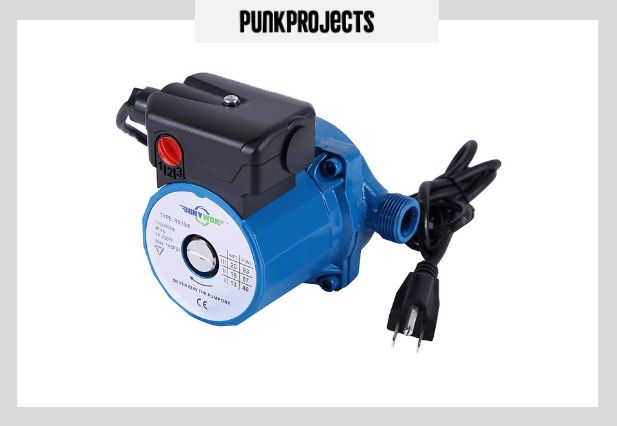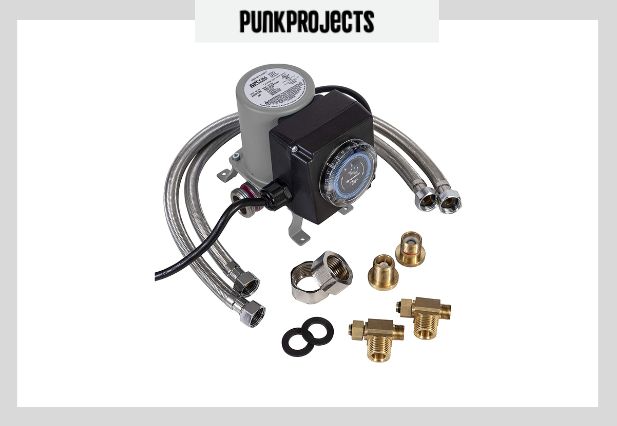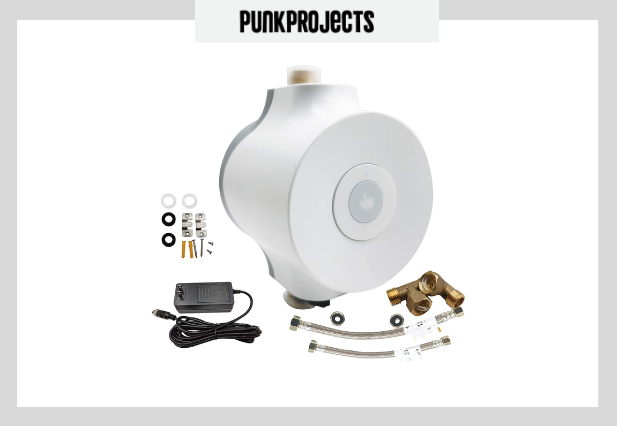A hot water recirculation pump is a device that helps to keep hot water constantly available at the faucet or shower without having to wait for it to heat up. This can save time and reduce energy consumption, making it an essential addition to any home.
Choosing the best hot water recirculation pump can be a challenge, as there are many different models and brands on the market. Factors such as flow rate, power consumption, installation requirements, and features like timers or temperature controls must all be taken into account when making a selection.
5 Best Hot Water Recirculation Pump
Hot water recirculation pumps are an innovative solution for those who want hot water anytime they need it, without the wait or waste associated with traditional heating systems.
These pumps work by circulating hot water through the pipes of your home, ensuring that hot water is readily available at any faucet in your house. With so many options on the market, it can be overwhelming to choose the right one for your needs.
In this article, we’ll explore four of the best hot water recirculation pumps currently available. We’ll examine their features, benefits and drawbacks to help you make an informed decision about which pump is right for you.
1. Best Hot Water Recirculation Pump: Watts Premier Instant Hot Water

By installing the Watts Hot Water Recirculating Pump hot water recirculating pump with timer, you can have hot water available at every faucet or shower whenever required. This can help save up to 15,000 gallons of water annually by preventing wastage. The pump is easy to install and does not require any extra piping.
Its distinctive design guarantees noiseless and trouble-free operation. Additionally, it comes with a built-in 24-hour dual-setting programmable timer that activates the pump only when necessary. However, please keep in mind that this product is not compatible with tankless water heaters.
2. BOKYWOX 110V NPT3/4” Domestic Hot Water Circulation Pump

The pump undergoes a special anti-rust treatment that makes it highly resistant to high temperatures and corrosion. It also has anti-fraying properties and a long lifespan, ensuring that it remains rust-free. Additionally, it is designed to prevent leakage, operate with low noise levels, and be environmentally friendly. Its attractive appearance makes it easy to install and operate responsibly.
This hot water circulation pump boasts a powerful motor and dependable performance, all while emitting minimal noise. At an average noise level of 25dB, you can enjoy its benefits without any interruptions to your daily routine.
3. Under Sink Hot Water Recirculating Pump : APCOM UT1 Hot Water Recirculation Pump For Under Sink

Experience hot water instantly with the comfort and convenience of having it in your home without any delays. This circulator is highly efficient, reducing waste and costs associated with water consumption. It operates fully automatically and is controlled by a built-in thermostat and timer to conserve water.
The pump typically runs for one to two minutes, three to four times per hour. With just one wrench, you can install the kit that includes a stainless steel pump, two braided hoses, two tees, and all the necessary fittings in under 10 minutes. The pump is designed for indoor installation and does not require a plumber.
4. Hot Water Recirculating Pump With Temperature Sensor : PROZRTED Smart Instant Hot Water Recirculating Pump System

By providing instant hot water, PROZRTED has put in a lot of effort to help you conserve your water, energy, and time. We are firm believers in the transformative power of technology. Our smart pump boasts advanced features such as a highly accurate built-in thermostat and a state-of-the-art water flow sensor. This ensures that you no longer have to wait or waste resources.
The Smart Pump offers three modes: Smart mode ensures that hot water is always instantly available, Energy-saving mode automatically decreases the temperature setting point if hot water is not used for some time, and Manual mode is the most energy-efficient mode where the pump is started a few minutes before hot water is needed.
The pump has three running speeds and a Smart memory function that remembers the last settings when powered off. It works seamlessly with smart plugs.
Hot Water Recirculation Pump Installation
Installing a hot water recirculation pump can help provide instant hot water at faucets and fixtures in your home, reducing water waste and waiting time. Here’s a general guide to help you with the installation process:
- To begin, collect all the required items for the task. This includes a hot water recirculation pump kit, comprising the pump, check valves, pipe connectors, and any other accessories mentioned in the manufacturer’s guide. In addition, you may require standard plumbing equipment such as a wrench, pipe cutter, and joint compound.
- Locate the perfect position: Locate the most appropriate spot for installing the recirculation pump, typically in proximity to the water heater and preferably on the hot water pipe.
- To avoid any possible leaks during the installation, find the main valve that controls the water supply and shut it off, which will halt the water flow throughout the entire house.
- To drain the water heater, connect a hose to the drain valve situated at the base of the appliance and direct the other end towards an appropriate drainage location. Turn on the drain valve and let all the water from the heater flow out.
- Cut into the hot water line: Make a precise cut with a pipe cutter on the hot water line at the location where you intend to set up the recirculation pump, ensuring that there are no rough edges or burrs on the cut.
- Install the recirculation pump: To install the pump on the hot water line, adhere to the guidelines given by the manufacturer. Normally, this requires connecting the pump and check valves using the given connectors. Ensure that you position the pump in accordance with the flow direction specified on the device.
- Connect the recirculation line: Make sure to install the recirculation line that will transport the hot water from the pump back to the water heater. Typically, this line is connected to the hot water line near the fixture that is farthest away in the recirculation loop. Use suitable connectors and ensure a tight and leak-proof connection.
- Power the pump: To connect the recirculation pump to a power source, you need to follow the manufacturer’s instructions. Before making any electrical connections, make sure to turn off the power and take necessary safety measures.
- Test the system: After finishing the installation, switch on the main water supply valve and inspect for any leakage. Eliminate any air from the system by turning on the hot water taps at different fixtures. Assess the recirculation pump’s performance by sensing hot water at the assigned faucets after a brief period.
- Adjust settings and fine-tune: Some recirculation pumps have adjustable settings to control when the pump operates. Consult the manufacturer’s instructions to set the desired temperature and timing parameters according to your preferences.
Remember, the steps provided here are a general guide, and it’s essential to refer to the specific instructions provided by the manufacturer of your recirculation pump.
If you are uncertain about any aspect of the installation process, it’s recommended to consult a professional plumber to ensure a safe and proper installation. Check also: How to Flush Water Heater (Why & Maintenance)
Hot Water Recirculating Pump Without Return Line
A hot water recirculating pump typically requires a dedicated return line to function properly. However, if you don’t have a return line, there are alternative options available to achieve hot water recirculation.
- Recirculating Pump with Integrated Check Valve: Hot water recirculating pumps that have an integrated check valve can be installed on the hot water outlet pipe of the water heater, eliminating the need for a separate return line. These pumps push hot water into the cold water line, creating a loop that circulates hot water throughout the plumbing system.
- Point-of-Use Recirculating Systems: A point-of-use recirculating system is an alternative choice. These systems have a small pump placed underneath the sink that is the furthest from the water heater, usually in the bathroom. The pump can be turned on by either a switch or motion sensor, and it rapidly circulates hot water from the main supply line to the designated faucet or fixture, eliminating the waiting time for hot water.
- Dedicated Hot Water Loop: When building or renovating your house, you might want to think about setting up a dedicated hot water loop. This means you would connect each fixture to the water heater through a separate pipe and then link them back together, forming a continuous loop. This system guarantees that hot water is always accessible at every fixture without the requirement of a recirculating pump.
It’s important to note that while these alternatives can help improve hot water availability and reduce water wastage, they may not provide the same level of energy efficiency as a traditional hot water recirculating system with a dedicated return line. It’s recommended to consult with a plumbing professional to determine the most suitable option for your specific situation.
How long do hot water recirculating pumps last?
On average, most manufacturers estimate that these pumps can last up to 5-10 years with regular use and proper maintenance. However, some high-end models can last up to 15 years or more if correctly maintained.
To ensure that your hot water recirculating pump lasts as long as possible, it’s essential to schedule regular maintenance checks with an experienced plumber.
Do recirculation pumps waste water?
The truth is that recirculation pumps do not waste water. In fact, they can actually save a significant amount of water and reduce your overall utility costs. Without a recirculation pump, you might have to run the tap for several minutes before getting hot water. This wastes a lot of precious resources and increases your monthly bills.
By installing a recirculation pump, you can avoid this wastage and enjoy instant access to hot water without any delay. The pump will circulate hot water through your pipes continuously so that it is always readily available when you need it.
Can you circulate hot water without a pump?
The simple answer is yes, you can. In fact, there are several ways to circulate hot water without the use of a pump. One way is to use natural convection currents, which occur when hot water rises and cooler water sinks. This process causes a natural flow of water that can be used to circulate hot water throughout your home.
Another way to circulate hot water without a pump is by using gravity-fed systems. These systems work by placing the boiler or tank above the point of use, allowing gravity to do the work. As the heated water rises, it flows through pipes and into radiators or other heating elements before returning back down to the boiler or tank through separate pipes.
While these methods may not be as efficient as using a pump, they are still effective alternatives that can save energy and money.
I am a multi-talented designer and contractor with over 10 years of experience in the field. I have a passion for creating beautiful, innovative spaces that reflect my clients’ needs and styles. My skills include architectural design, interior design, space planning, project management and construction supervision.






